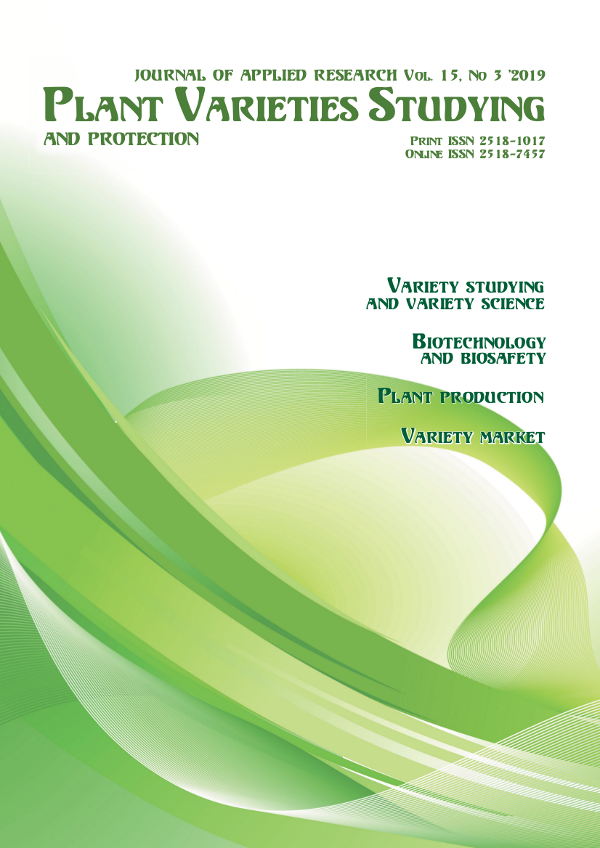Features of forming a conveyor of commodity products of lettuce, Lactuca sativa L., varieties in the Western Forest-Steppe of Ukraine
DOI:
https://doi.org/10.21498/2518-1017.15.3.2019.181085Keywords:
lettuce, variety, growth and development, phenology, biometrics, edible organ, crop capacity, identification, conveyorAbstract
Purpose. To reveal the scientific bases of forming the conveyor production of commercial products of lettuce, Lactuca sativa L., varieties in the conditions of the Western Forest-Steppe of Ukraine.
Methods. Field research was conducted during 2015–2017 at the research field of the Department of Horticulture and Vegetable Growing of the Lviv National Agrarian University in accordance with the Methodology on Experimental Techniques in Vegetable and Melon Growing (2001) and Methods of Expertise of lettuce, Lactuca sativa L., varieties.
Results. It is revealed that the soil and climatic conditions of the Western Forest-Steppe of Ukraine contribute to the optimal growth and development of all lettuce varieties of the corresponding types, as evidenced by the structure of conveyor receipt of fresh commodity products to the consumer (first decade of April – first decade of November). The shortest growing season was provided by lettuce varieties var. secalina ‘Zorepad, ‘Malakhit, ‘Dublianskyi’, which have the shortest period from seedlings to technical ripeness (21–42 days). Therefore, varieties of this variation occupy the largest share in the conveyor production of commercial products, which, with early spring sowing in open ground (April 14–20), comes to the consumer in the first decade of May. Winter sowing (21.11) ensured the receipt of fresh produce in the first decade of April. Commercial products by mass of edible organs, shape of the rosette of leaves (heads, stems), color, consistency and taste qualities corresponds to the technical requirements for Lactuca sativa L.
Conclusions. The selection of varieties of lettuce for the conveyor production of commercial products should be carried out taking into account the variety of the corresponding type, ripeness group, and timing of sowing. The receipt of fresh lettuce to the consumer is directly dependent on the timing of seeds sowing (early spring, late spring, summer-autumn and winter).
Downloads
References
Ulianych, O. I., & Keckalo, V. V. (2011). Salat posivnyi [Lettuce]. Uman: N.p. [in Ukrainian]
Leshchuk, N. V. (2010). Conveyer Production Composition of Cutting Lettuce Commercial Yield (Lactuca sativa L.) in the Conditions of Ukrainian Woodlands. Plant Var. Stud. Prot., 1, 82–88. doi: 10.21498/2518-1017.1(11).2010.59481. [in Ukrainian]
Atlas morfolohichnykh oznak salatu posivnoho Lactuca sativa L. [Atlas of morphological characteristics of lettuce Lactuca sativa L.]. (2010). Kyiv: Feniks. [in Ukrainian]
Bondarenko, H. L., & Yakovenko, K. I. (Eds.). (2001). Metodyka doslidnoi spravy v ovochivnytstvi i bashtannytstvi [Methods of conducting experiments in vegetable and melon growing]. (3rd ed., rev.). Kharkiv: Osnova. [in Ukrainian]
Leshchuk, N. V. (Ed.). (2007). The technique of examination of varieties of lettuce (Lactuca sativa L.) for difference, uniformity and stability. Okhorona prav na sorty roslyn [Protection of Rights to Plant Varieties], 3(2), 366–379. [in Ukrainian]
UPOV. (2017). Lettuce. Guidelines for the conduct of tests for distinctness, uniformity and stability. Retrieved from http://www.upov.int/edocs/tgdocs/en/tg013.pdf
Kondratenko, S. I., Mohylna, O. M., Horova, T. K., Khareba, O. V., Kuts, O. V., Tkalych, Yu. V., ... Pozniak, O. V. (2015). Metodyka-klasyfikator provedennia ekspertyzy sortiv na vidminnist, odnoridnist ta stabilnist salatu posivnoho [Method-classifier for the examination of lettuce varieties for the difference, uniformity and stability]. Kharkiv: TOV “VP Pleiada”. [in Ukrainian]
Tekhnolohiia vyroshchuvannia salativ [Lettuce growing technology]. (2017). Kyiv: N.p. URL: https://www.rijkzwaan.ua/sites/default/files/booklet-rijkzwaan-salat-2017-a4_2.pdf [in Ukrainian]
Downloads
Published
How to Cite
Issue
Section
License
Copyright (c) 2019 Ukrainian Institute for Plant Variety Examination

This work is licensed under a Creative Commons Attribution-ShareAlike 4.0 International License.
Starting in 2022, the copyright to the publication remains with the authors
Our journal abides by the CREATIVE COMMONS copyright rights and permissions for open access journals.
Authors, who are published in this journal, agree to the following conditions:
- The authors reserve the right to authorship of the work and pass the first publication right of this work to the journal under the terms of a Creative Commons Attribution License, which allows others to freely distribute the published research with the obligatory reference to the authors of the original work and the first publication of the work in this journal.
- The authors have the right to conclude separate supplement agreements that relate to non-exclusive work distribution in the form in which it has been published by the journal (for example, to upload the work to the online storage of the journal or publish it as part of a monograph), provided that the reference to the first publication of the work in this journal is included.

























 Ukrainian Institute for Plant Varieties Examination
Ukrainian Institute for Plant Varieties Examination  Селекційно-генетичний інститут
Селекційно-генетичний інститут Institute of Plant Physiology and Genetics of the National Academy of Sciences of Ukraine
Institute of Plant Physiology and Genetics of the National Academy of Sciences of Ukraine
 The National Academy of Agrarian Sciences of Ukraine
The National Academy of Agrarian Sciences of Ukraine